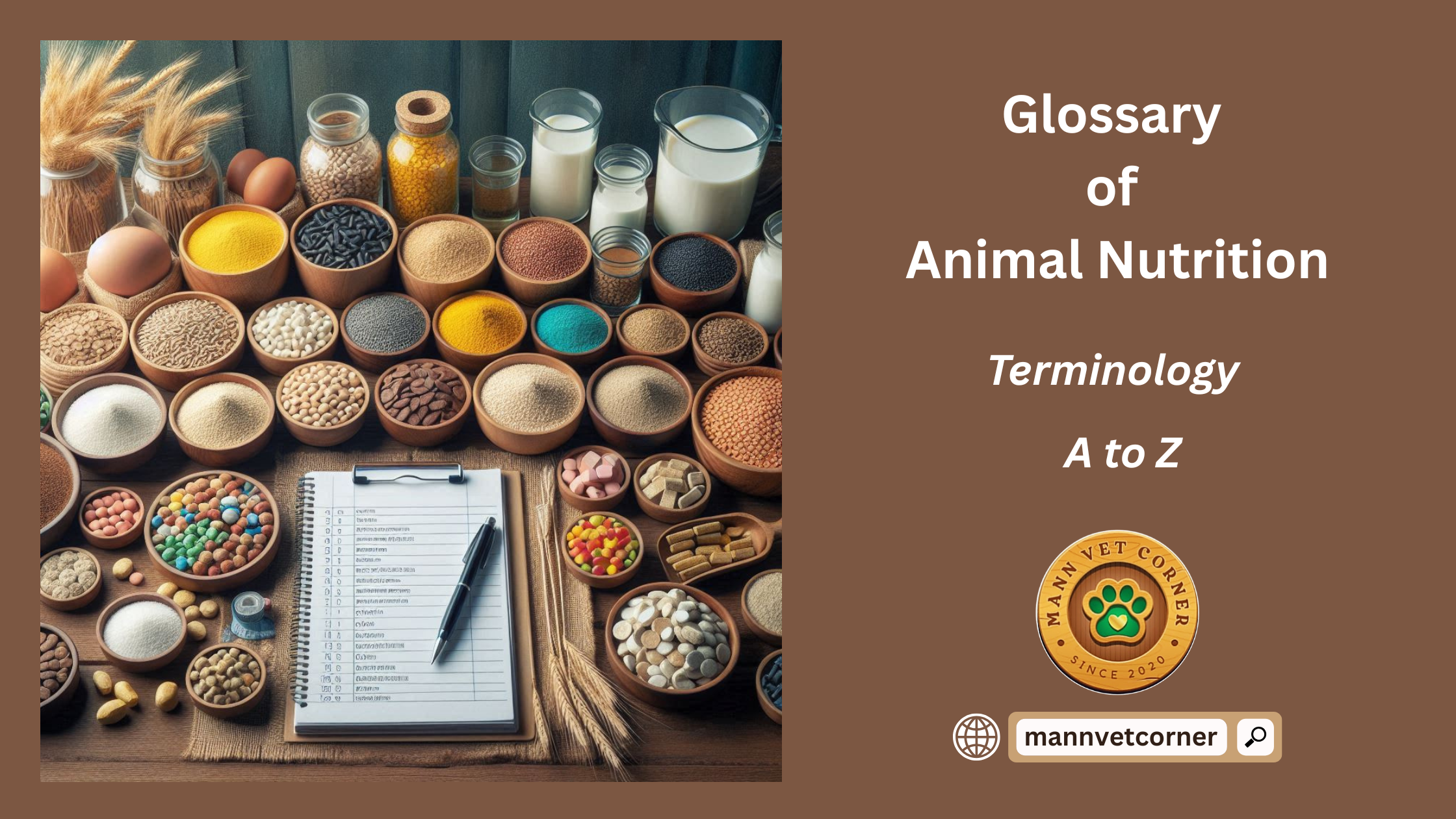This is a comprehensive glossary of terms related to Animal Nutrition, arranged alphabetically from A to Z. This list includes key concepts, nutrients, feed types, digestive processes, and nutritional requirements essential to understanding how animals derive nourishment from their diets. Each term is briefly defined to provide clarity on its role in animal nutrition.
A
- Acidifiers: Organic acids added to feed to lower gut pH and inhibit harmful bacteria.
- Acidosis: A condition in ruminants caused by a drop in rumen pH due to excessive fermentable carbohydrates.
- Ad libitum: A feeding method allowing unrestricted access to feed.
- Algae-based feeds: Nutrient-rich feeds derived from algae, offering sustainable protein and omega-3 sources.
- Amino acids: Building blocks of proteins; essential ones must be dietary-supplied.
- Antibiotics: Medications for bacterial infections, sometimes used in feed (declining due to resistance).
- Antioxidants: Substances that protect cells from free radical damage.
- Ash: Inorganic residue after burning feed, reflecting mineral content.
- Autophagy: Cellular recycling of damaged components, influenced by nutrition.
B
- Basal metabolism: Minimum energy for basic life processes at rest.
- Bioavailability: Proportion of a nutrient absorbed and utilized.
- Biotin: B-vitamin aiding carbohydrate, fat, and protein metabolism.
- Bloat: Gas accumulation in the rumen causing distension in ruminants.
- Butyrate: A volatile fatty acid from gut fermentation, supporting colon health.
- Byproduct feeds: Secondary products (e.g., distillers’ grains) used as feed.
C
- Calorie: Energy unit measuring feed content.
- Carbohydrates: Major energy source composed of carbon, hydrogen, and oxygen.
- Cellulose: Plant cell wall carbohydrate, digestible by ruminant microbes.
- Chelates: Minerals bound to organic molecules for improved absorption.
- Choline: Nutrient vital for liver function and fat metabolism.
- Circular nutrition: Recycling waste into sustainable feed.
- Coccidiostats: Additives controlling coccidiosis in livestock.
D
- Deficiency: Nutrient lack causing health or performance issues.
- Digestibility: Proportion of feed absorbed post-digestion.
- Dietary fiber: Indigestible plant material aiding gut health.
- Dry matter: Feed portion remaining after water removal.
- Dysbiosis: Gut microbiome imbalance linked to poor nutrition.
E
- Electrolytes: Minerals (e.g., sodium) essential for fluid balance.
- Energy: Capacity for work from nutrients like fats and proteins.
- Enrichment feeding: Feed delivery stimulating natural behaviors.
- Enzymes: Proteins enhancing digestion; used as additives.
- Epigenetics: How nutrition influences gene expression without DNA changes.
F
- Fat-soluble vitamins: Vitamins A, D, E, K stored in fat.
- Fatty acids: Fat components; omega-3 and omega-6 are essential.
- Feed conversion ratio (FCR): Feed amount per unit of animal product.
- Feedstuff: Any material used as feed (e.g., grains, forages).
- Fermentation: Microbial breakdown of feed in the rumen or hindgut.
G
- Gelatinization: Process making starch more digestible via heat.
- Glucagon: Hormone raising blood glucose by glycogen breakdown.
- Glycogen: Stored glucose in liver and muscles.
- Gut microbiome: Digestive tract microorganisms aiding nutrient absorption.
H
- Hay: Dried forage (e.g., grasses) used as feed.
- Hemicellulose: Partially digestible plant cell wall carbohydrate.
- Herbivore: Plant-eating animal.
- Hindgut fermentation: Fermentation in monogastric large intestines (e.g., horses).
I
- Ileum: Final small intestine section for nutrient absorption.
- Insect meal: Sustainable protein from insects.
- Insulin: Hormone lowering blood glucose by uptake into cells.
- Intake: Feed amount consumed over time.
J
- Jejunum: Middle small intestine section for nutrient absorption.
- Joule: Scientific energy unit for feed content.
K
- Ketosis: Metabolic disorder with elevated ketones, common in dairy cows.
- Kilocalorie (kcal): 1,000 calories, used for feed energy.
L
- Lactation: Milk production in mammals.
- Lignin: Indigestible plant polymer reducing digestibility.
- Lipids: Fats and oils providing energy and fatty acids.
- Lysine: Essential amino acid critical for growth.
M
- Macronutrients: Large-amount nutrients (e.g., proteins, fats).
- Metabolism: All chemical reactions involving nutrients.
- Micronutrients: Small-amount nutrients (e.g., vitamins).
- Molasses: Sugar byproduct, energy-rich feed additive.
- Monogastric: Single-stomach animals (e.g., pigs).
N
- Nitrogen: Key element in proteins.
- Non-protein nitrogen (NPN): Sources (e.g., urea) for ruminant protein synthesis.
- Nutrigenomics: Study of nutrients’ effects on gene expression.
- Nutrient: Substance for growth and health.
O
- Omega-3 fatty acids: Essential fats reducing inflammation.
- Omnivore: Animal eating plants and animals.
- Organic matter: Carbon-containing feed portion, excluding ash.
- Osmosis: Water movement for fluid balance.
P
- Palatability: Feed appeal influencing intake.
- Phosphorus: Mineral for bones and energy metabolism.
- Phytase: Enzyme improving phosphorus availability in plants.
- Phytogenics: Plant-based additives enhancing health.
- Postbiotics: Probiotic metabolites benefiting gut health.
- Prebiotics: Ingredients promoting beneficial gut microbes.
- Precision nutrition: Tailored diets per animal’s needs.
- Probiotics: Live microbes for gut health.
- Protein: Amino acid-based macronutrient for growth.
Q
- Quality: Feed’s nutritional value and digestibility.
- Quinoa: High-protein grain for feeds.
R
- Ration: Daily feed meeting nutritional needs.
- Reticulorumen: Ruminant stomach compartments for fermentation.
- Roughage: High-fiber feeds supporting rumen function.
S
- Scurvy: Vitamin C deficiency disease.
- Silage: Fermented, high-moisture forage.
- Smart feeders: Automated systems adjusting rations.
- Starch: Plant carbohydrate, key energy source.
- Stress-induced nutrient requirements: Increased needs during stress.
T
- Thiamine: Vitamin B1 for metabolism and nerve function.
- Total digestible nutrients (TDN): Measure of feed energy.
- Trace minerals: Tiny-amount minerals (e.g., zinc).
U
- Urea: Nitrogen supplement for ruminants.
- Urinary calculi: Stones from mineral imbalances.
V
- Vitamins: Organic compounds for physiological functions.
- Volatile fatty acids (VFAs): Rumen fermentation products, energy sources.
W
- Water: Essential for digestion and regulation.
- Weaning: Transition from milk to solid feed.
X
- Xanthophylls: Pigments enhancing egg yolk color.
- Xylose: Sugar in hemicellulose.
Y
- Yeast: Microorganism improving digestion in feeds.
- Yolk: Nutrient-rich egg part.
Z
- Zinc: Trace mineral for immunity and growth.
- Zoonosis: Diseases linked to nutrition and health.
